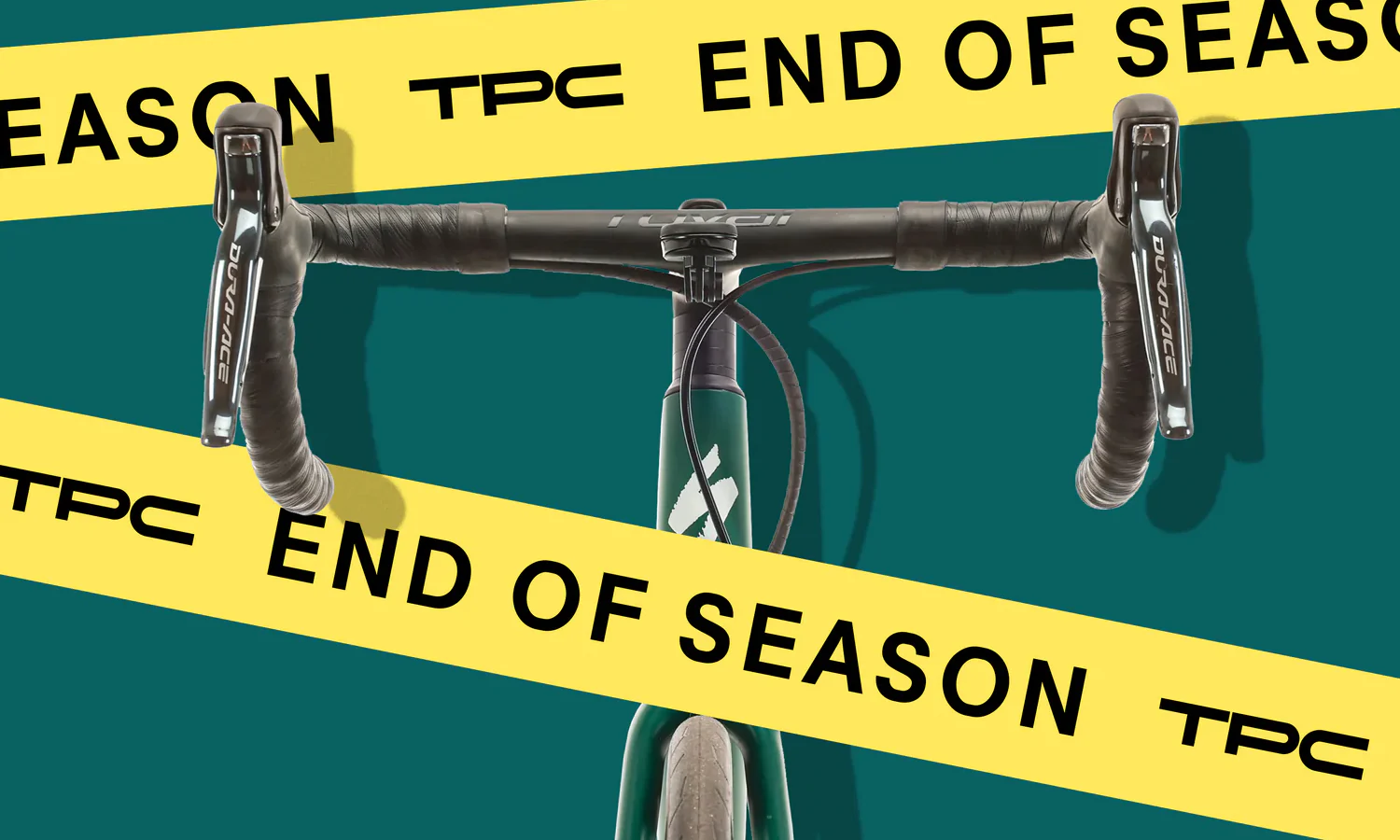When roads and trails get wet and dirty, your bike tends to end up wet and dirty too. Washing your bike and keeping it clean isn’t the most exciting or glamorous part of cycling, but it’s an essential part of maintaining your bike. A clean bike not only looks nicer but it makes it easier to spot and fix important mechanical issues that might pop up. Getting mud and gunk off your drivetrain helps your bike shift better and reduces friction and wear. It’s easy to give your bike a pro-level wash at home. Here’s how.
Contents
- How to wash your bike: The basics
- How TPC washes and cleans bikes
- The best way to clean your bike chain and drivetrain
- How to wash and clean your bike without a hose
- How often should you wash your bike?
[button]SHOP BIKE TOOLS & MAINTENANCE[/button]
How to wash your bike: The basics
Tools and items needed
- Water source: Hose, spray bottle, pump sprayer, shower, car wash
- Mild soap: Dawn dish soap or bike-specific soap
- Soft brush or sponge for the frame
- Brush for the drivetrain
- Soft towel or microfiber
- Chain lube
- Bucket(s)
- (Optional) Degreaser
- (Optional) Protectant: Pedro’s Bike Lust, Muc-Off Bike Protect
[product-block handle="muc-off-bike-care-kit-wash-and-drivetrain-essentials"/]
Quick tips
- Your drivetrain is the most important component to keep clean. Even if you never wash your bike, at a bare minimum you should keep your drivetrain clean and lubricated.
- Don’t direct a high-pressure spray at parts that spin or move (e.g., bottom bracket, headset, hubs, suspension pivots, suspension stanchions). This can drive out grease/drive in dirt, decreasing bearing life.
- For deep cleaning, removing your wheels will allow you to reach all the nooks and crannies where dirt likes to hide.
- If washing an E-bike, make sure it’s turned off. Avoid using too much water near motors, battery connections, and charge ports. Do not charge the bike right after washing it.
- Don’t let water sit on your bike. Dry your bike immediately after washing it.
How TPC washes and cleans bikes
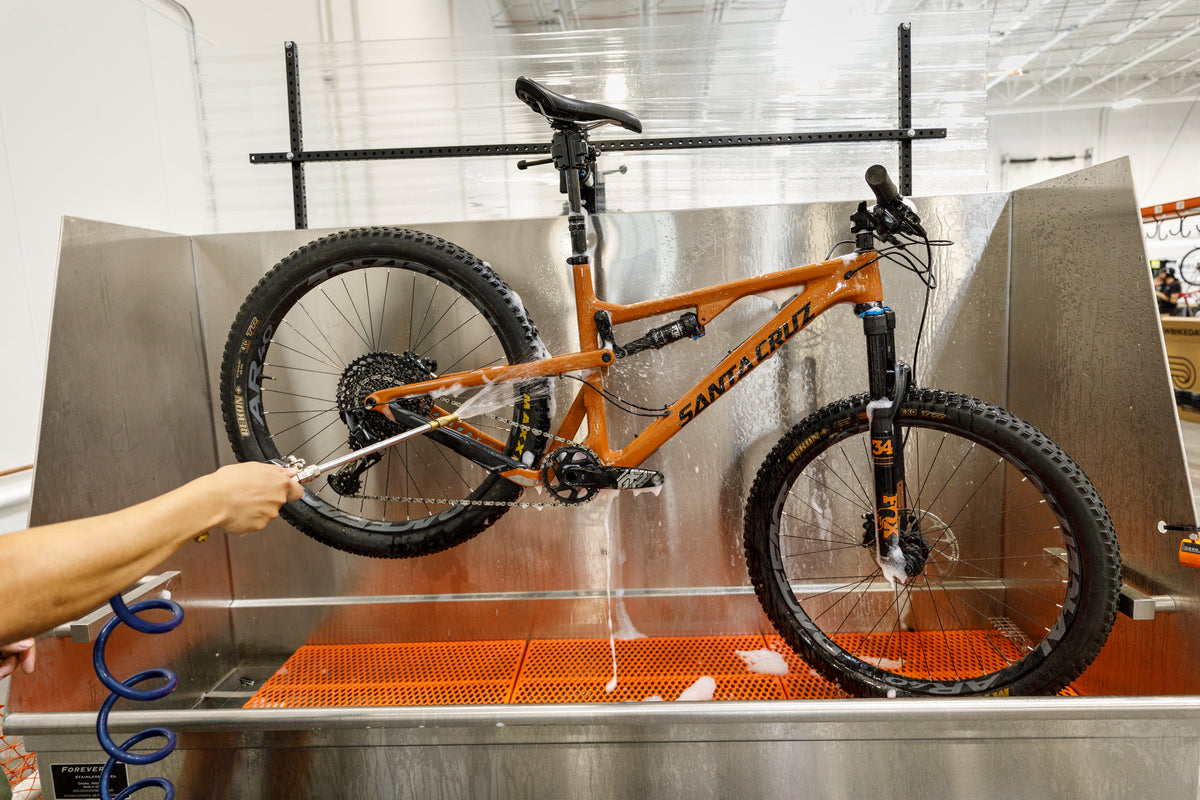 Here at TPC our professional bike technicians service and inspect up to 100 bikes a day. The first step is getting the bike clean. One of our Master Techs, Billy Findlay, explained, “A clean bike lets us spot cracks and other issues. Sometimes, just cleaning a really dirty and neglected bike will get it feeling close to new again.”
Here at TPC our professional bike technicians service and inspect up to 100 bikes a day. The first step is getting the bike clean. One of our Master Techs, Billy Findlay, explained, “A clean bike lets us spot cracks and other issues. Sometimes, just cleaning a really dirty and neglected bike will get it feeling close to new again.”
We use custom-built bike wash stations. These have a tub with a built-in bike stand to hold the bike up and collect water. Mechanics washing bikes have access to a hose, two buckets, and a selection of brushes. Here is the process our mechanics use to make sure our bikes are completely spotless:
1.Prepare two buckets of soapy water, one for the drivetrain and one for the frame.
2. Apply degreaser to the drivetrain and allow it to penetrate.
3. Wash and scrub the drivetrain using the drivetrain bucket and a stiff brush.
4. Wash the frame, cockpit, and wheels using the frame bucket and a soft brush.
5. Rinse the soap off of the entire bike.
6. Dry the frame, cockpit, and wheels with a towel.
7. Apply bike protectant to the frame and wheels.
8. Dry the drivetrain and lubricate the chain.
There are a few key things our mechanics do to go the extra mile when washing a bike.
Separate drivetrain and frame buckets and brushes
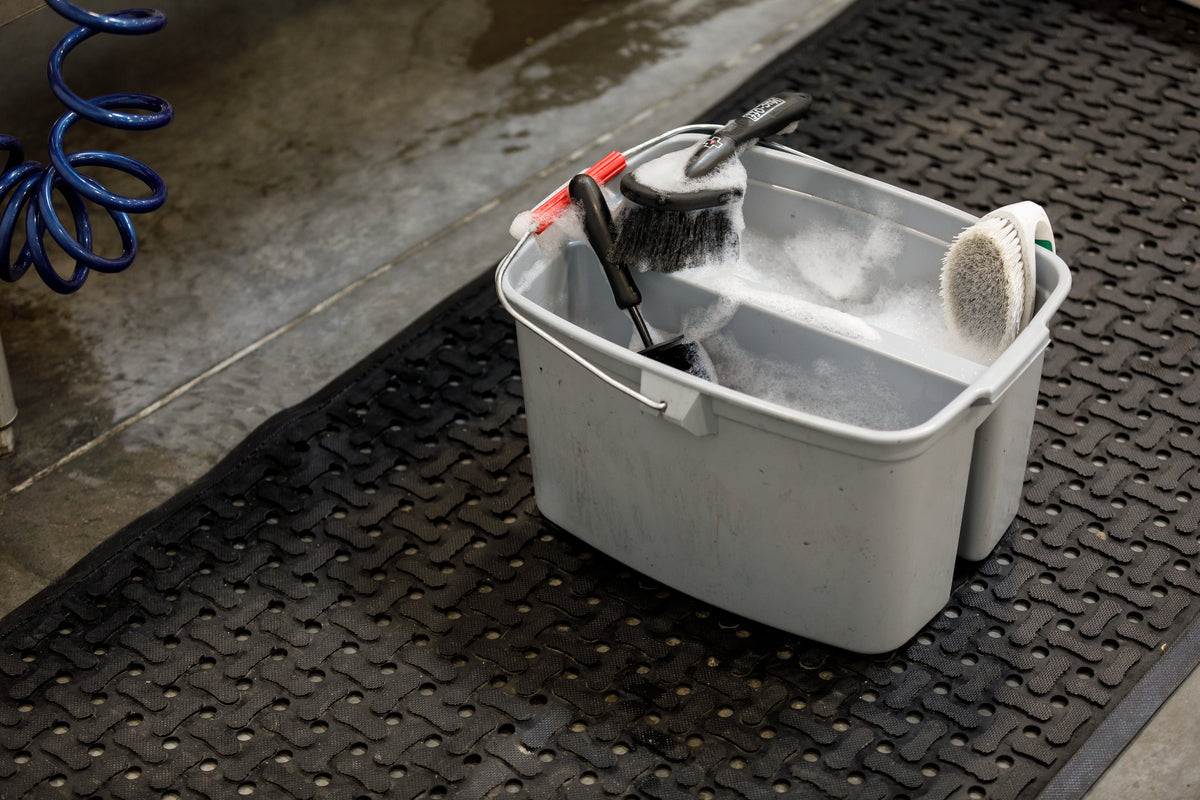 First, they use separate buckets of soapy water for the frame and drivetrain. This keeps the grit and grime from the drivetrain from scratching the frame or other components. At home, you can use the same method, or just fill your bucket with clean soap and water when switching from the drivetrain to the frame. Always use a different brush/sponge for the drivetrain and frame. A stiff brush is good for the drivetrain because it helps lift grime. A soft brush or sponge is good for the frame because it prevents scratches.
First, they use separate buckets of soapy water for the frame and drivetrain. This keeps the grit and grime from the drivetrain from scratching the frame or other components. At home, you can use the same method, or just fill your bucket with clean soap and water when switching from the drivetrain to the frame. Always use a different brush/sponge for the drivetrain and frame. A stiff brush is good for the drivetrain because it helps lift grime. A soft brush or sponge is good for the frame because it prevents scratches.
Drivetrain degreaser
Before washing the rest of the bike, our mechanics apply a bike-specific degreaser to the drivetrain. A degreaser isn’t always necessary, since soapy water and a brush will work fine, but it can make cleaning the drivetrain easier, especially if it’s extremely grimy. If you do choose to use a degreaser, it’s best to use one designed for bikes so you don’t risk stripping or damaging sensitive components.
Dawn dish soap
At TPC we use blue Dawn dish soap to wash our bikes. Blue Dawn is actually the soap recommended by several bike manufacturers because it’s very gentle, so it will remove dirt, grime, and oil without stripping or damaging your paint or components. A bucket of water only needs about a teaspoon of Dawn to be effective. There are also great bike-specific soaps that work extremely well, though they tend to be more expensive.
Bike Protectant
While drying bikes, our Bike Techs apply a bike-specific protectant. Our favorite products are Pedro’s Bike Lust and Muc-Off Bike Protect. These protectants make your bike look nice and leave a protective layer that helps it stay cleaner for longer. To prevent messes and keep the protectant from contaminating components like brake pads (DO NOT spray protectant on brake pads), spray the protectant onto a soft towel or microfiber and wipe it onto your frame and wheels.
The best way to clean your bike chain and drivetrain
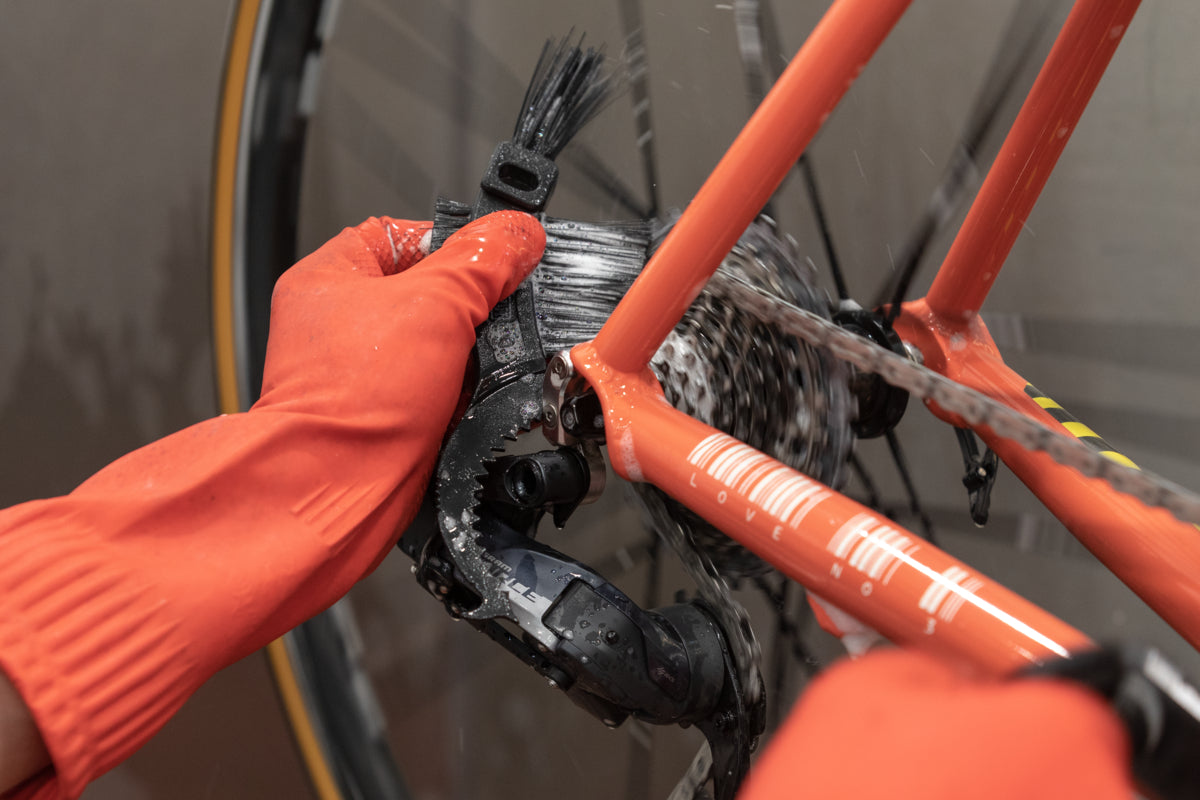 The most important part of your bike to clean is the drivetrain. You could ignore washing the rest of your bike, and as long as you keep your drivetrain clean, your bike will keep working well for a very long time. With light dust or grime, thoroughly wiping your chain and cogs with a rag and then applying chain lube may be enough. I do this every few rides or after every wet ride.
The most important part of your bike to clean is the drivetrain. You could ignore washing the rest of your bike, and as long as you keep your drivetrain clean, your bike will keep working well for a very long time. With light dust or grime, thoroughly wiping your chain and cogs with a rag and then applying chain lube may be enough. I do this every few rides or after every wet ride.
But to fully clean your drivetrain, you’ll need to use water, soap or degreaser, and a brush. Any brush with stiff bristles will get the job done, and many cyclists just use an old toothbrush. You can also try out chain-cleaning brushes like the Finish Line Grunge Brush, which can make the job quick and easy.
[product-block handle="finish-line-grunge-brush-chain-and-gear-cleaning-tool-1"/]
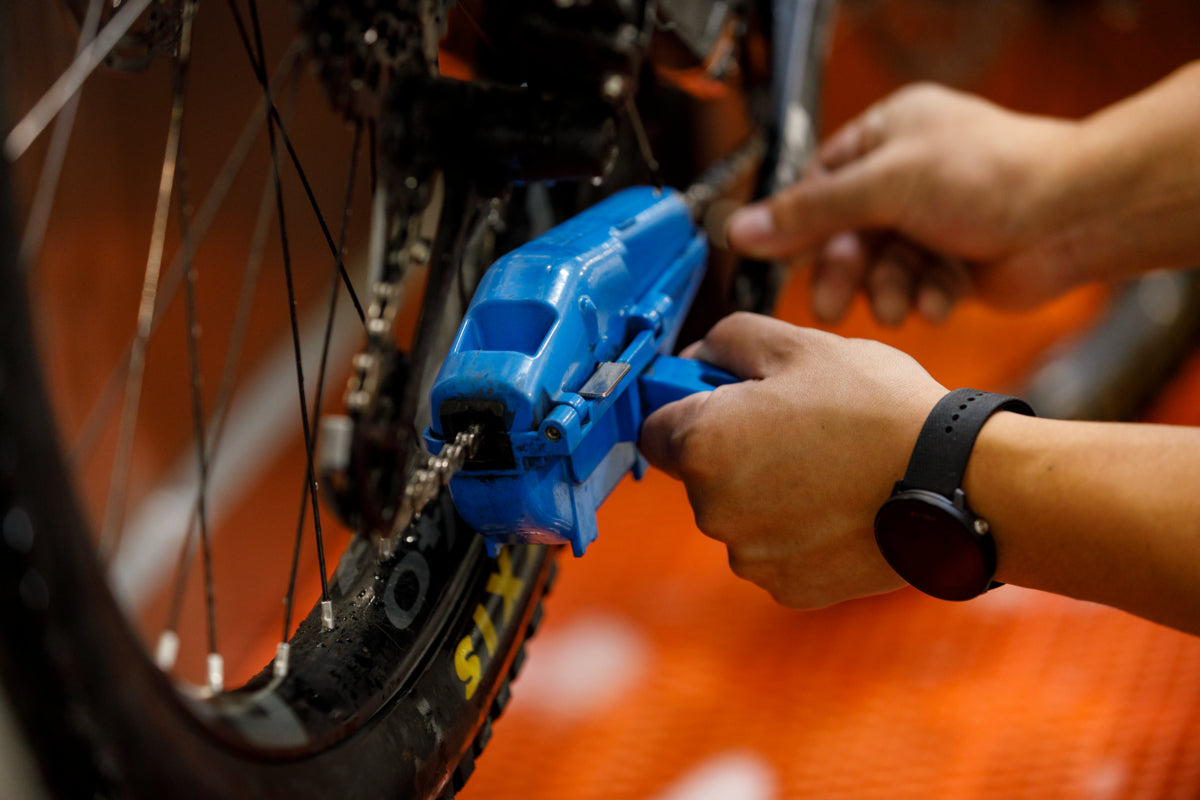 This will be overkill for most, but for the ultimate clean, our mechanics use the Park Tool Cyclone Chain Scrubber. You fill the reservoir with water and a tiny bit of soap or degreaser, clamp it around the chain, then backpedal the chain through the scrubber. Wipe it dry and you have a perfectly clean chain in seconds.
This will be overkill for most, but for the ultimate clean, our mechanics use the Park Tool Cyclone Chain Scrubber. You fill the reservoir with water and a tiny bit of soap or degreaser, clamp it around the chain, then backpedal the chain through the scrubber. Wipe it dry and you have a perfectly clean chain in seconds.
[product-block handle="park-tool-cm-5-3-cyclone-chain-scrubber-1"/]
Once you loosen all the dirt, grit, and grime on the chain, chainring(s), cassette, and derailleur pulleys with a brush and soap, rinse it clean. Dry the drivetrain with a rag, or if you have an air compressor, you can use compressed air. When the chain is dry, apply chain lube, then you’re ready to go. Always lube your chain soon after washing to prevent any oxidation on the surface of the chain.
How to wash and clean your bike without a hose
@theproscloset Landlords hate us for this one simple trick! #fyp #theproscloset #tipsandtricks #funny #mtb ♬ original sound - vintage
If you don’t have access to a hose, how do you wash your bike? You could just use a bucket, but filling one up multiple times to rinse your bike isn’t very efficient or fun. Fortunately, there are a few clever alternatives.
Spray bottle
The cheapest and most compact option is a basic spray bottle. A heavy-duty sprayer from a hardware store is actually super effective on dirt and mud if you fill it with hot water. It’s also easy to use indoors if you don’t have an outdoor space for bike washing or it’s winter outside. It’s what I used to wash my bike in my kitchen when I lived in a small apartment.
Pump sprayer
Pump sprayers can be found in most hardware stores and are usually used by gardeners for spraying weeds. You fill the bottle with water and pressurize it with a hand pump. We actually use pump sprayers to store and spray bike degreasers at our wash stations. For most home washing situations, this would be my top choice.
Car wash
A coin-operated car wash is a great option, as long as you’re careful with the high-pressure spray. Use low pressure, especially on any parts that spin or move. Ideally, bring your own soap and brushes instead of using what the car wash provides to ensure no harsh chemicals end up on your bike.
Shower
This is an option if you have to wash your bike indoors and don’t have an area in your home you can get wet. I consider this a last resort because most showers are too small and it can be pretty awkward to stuff a bike in one. Unless you have a removable showerhead, you’ll still have to use a bucket, spray bottle, or pump sprayer.
How often should you wash your bike?
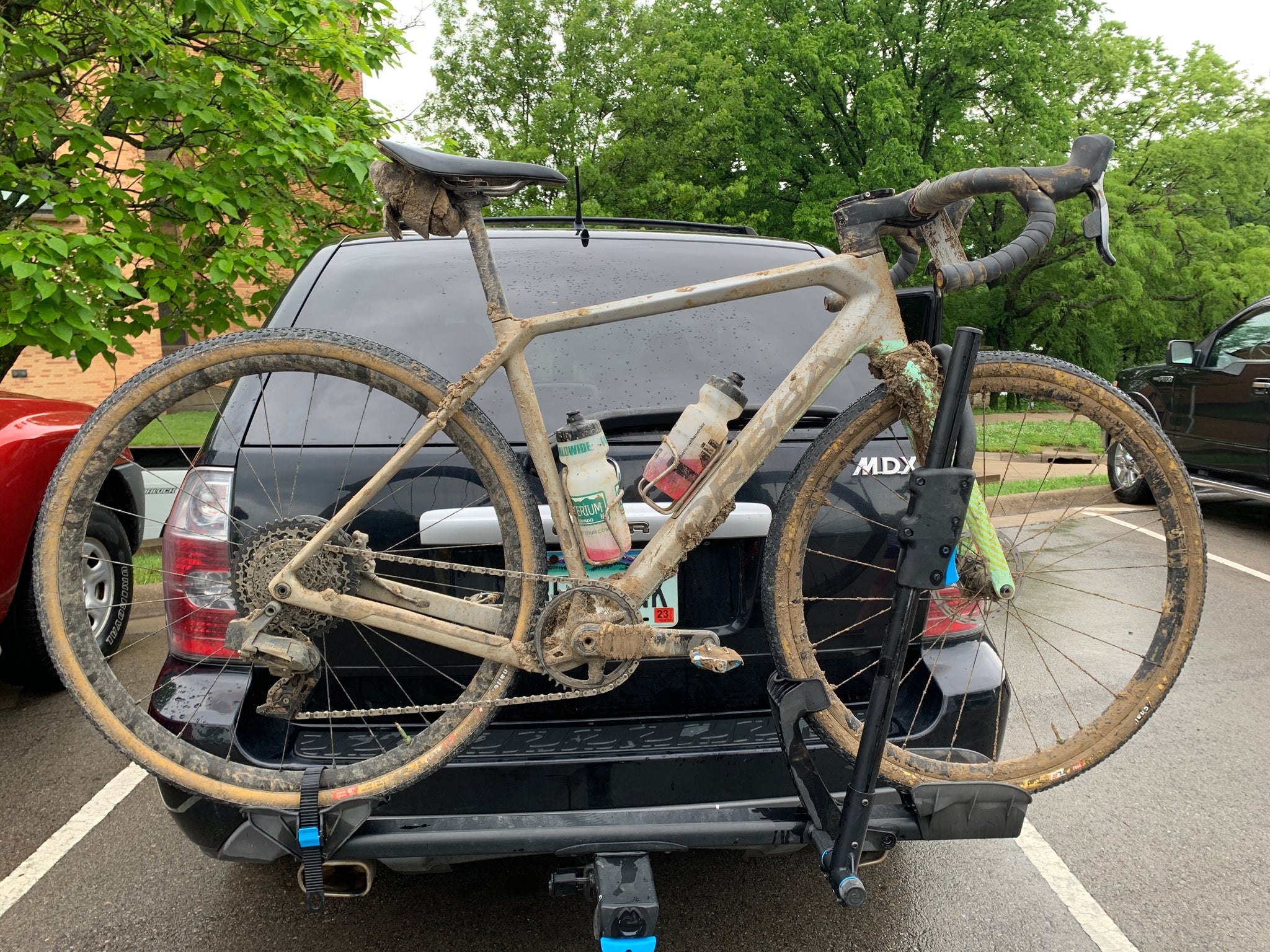 Yeah, it's probably time...
Yeah, it's probably time...
If you’re motivated, you can wash your bike after every ride. But most of us don’t have the time or energy for that. Really, it’s up to you. In the winter, I sometimes don’t wash my bike for months because I know it’s going to get splattered with mud on every ride. That said, I do wipe my chain down and re-lube it regularly, especially after dirty or wet rides. If it’s freezing cold out, I’ll just wash the drivetrain and call it good.
It is possible to wash your bike too much. Unless your bike is constantly muddy and dirty, frequent washing could be counterproductive. Santa Cruz, for example, specifically advises against over-washing its bikes:
“We did some experiments with bikes that were washed a lot but ridden infrequently, bikes that were ridden a lot but washed infrequently, and bikes that were both washed and ridden a lot. Guess what? Your bike hates only being washed and not being ridden. This test group had the worst results. They became creaky and not much fun to be around, much like the people who own bikes like that. Don't get all angry (you know who you are), you can still wash your bike from time to time — and there are those times where it has to be done after every ride. Everything needs more attention during those times. BUT, maybe you should examine your priorities. It's a mountain bike. You can get dirt on it. It's OK.”
I generally agree with their assessment. If you do wash your bike after every ride, just take care to not spray too much water on bearings and other moving parts and dry it well after. Often, putting a bike away wet is the cause of maladies like rust and creaks.
[button]SHOP BIKE TOOLS & MAINTENANCE[/button]


